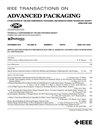Alignment and Performance Considerations for Capacitive, Inductive, and Optical Proximity Communication
引用次数: 26
Abstract
We present a comparative analysis of different physical approaches to chip-to-chip proximity communication, PxC, based on capacitive, inductive and optical signalling. Each method is modeled theoretically and the tolerances for packaging are identified. Analytical formulas for performance in terms of the pad size and pad spacing are derived and compared to reported experimental data. The tolerance of each communication method to misalignment is reported. The design space in terms of channel density and chip separation for capacitive and inductive proximity communication is explored for a specified bit-error-rate (BER) or signal-to-noise ratio (SNR) and transmitter power or voltage. The relative merits of each technology are discussed. A general conclusion is that capacitive proximity communication is advantageous for dense communication with small pads at low voltages and when low raw bit-error rates are required; however a hard requirement for vertical separation between chips is identified, independent of the area of the pads, and fixed by the supply voltage and the technology parameters. On the other hand, inductive communication provides a larger working range of chip separations, and is advantageous when larger pad sizes are used; however the minimum voltage is similarly constrained in order to maintain low bit-error rates. Optical proximity communication potentially provides the largest chip separations, but has low tolerance to in-plane misalignment.电容式、电感式和光学近距离通信的对准和性能考虑
我们提出了基于电容、电感和光信号的芯片到芯片接近通信PxC的不同物理方法的比较分析。对每种方法进行了理论建模,并确定了包装公差。推导了基于衬垫尺寸和衬垫间距的性能分析公式,并与报道的实验数据进行了比较。报告了每种通信方法对不对准的容忍度。针对特定的误码率(BER)或信噪比(SNR)以及发射机功率或电压,探讨了电容式和电感式近距离通信的信道密度和芯片间距方面的设计空间。讨论了每种技术的相对优点。一般的结论是,电容式近距离通信有利于在低电压和低原始误码率要求下使用小焊盘进行密集通信;然而,确定了芯片之间垂直分离的硬性要求,与焊盘的面积无关,并由电源电压和技术参数固定。另一方面,电感通信提供了更大的芯片分离工作范围,并且在使用更大的衬垫尺寸时是有利的;然而,为了保持低误码率,最小电压同样受到限制。光学近距离通信可能提供最大的芯片间距,但对面内偏差的容错性较低。
本文章由计算机程序翻译,如有差异,请以英文原文为准。
求助全文
约1分钟内获得全文
求助全文

 求助内容:
求助内容: 应助结果提醒方式:
应助结果提醒方式:


